What is Algae?
- Algae are simple, chlorophyll-containing organisms classified within the plant kingdom but distinct from higher plants. These organisms possess a plant body known as a thallus, which lacks the differentiation into roots, stems, or leaves typically observed in more complex plants.
- Algae are categorized under the division Thallophyta, which also includes fungi and lichens. This classification highlights their fundamental simplicity compared to more advanced plant forms. Unlike fungi, algae are characterized by the presence of chlorophyll, a pigment essential for photosynthesis. This key difference enables algae to produce their own food through photosynthesis, classifying them primarily as autotrophic organisms.
- In addition to their autotrophic mode of nutrition, some algae exhibit heterotrophic behaviors, where they obtain nutrients from complex organic substances rather than synthesizing their own food. There are also algal forms that display holozoic nutrition, ingesting solid particles for sustenance.
- Cyanobacteria, often called blue-green algae, are sometimes included in discussions about algae. However, most taxonomic authorities exclude prokaryotic organisms like cyanobacteria from the traditional definition of algae, focusing instead on eukaryotic forms.
What is the thallus organization of algae?
- Algae exhibit a diverse range of thallus organization, reflecting their evolutionary adaptations and ecological roles. The thallus, which is the body of the alga, does not differentiate into distinct roots, stems, or leaves as seen in higher plants. Instead, it exists in forms ranging from simple unicellular structures to complex multicellular arrangements.
- At the smallest scale, some algae, such as Micromonas pusilla, are unicellular, with diameters measuring just 1 μm. These microscopic forms are capable of completing their life cycles independently, demonstrating all necessary physiological and biochemical functions within a single cell. Unicellular algae may be motile or non-motile, and their ability to thrive in various environments is often enhanced by their simple structure.
- Unicellular algae can sometimes form colonial structures. These colonies consist of cells aggregated within a shared gelatinous matrix, representing an intermediate stage between unicellular and multicellular organization. This colonial form allows for a degree of coordination among cells while maintaining their individual capabilities.
- In terms of multicellular organization, algae exhibit a range of thallus types, including palmella, dendroid, palmelloid, coccoid, filamentous, siphonaceous, and heterotrichous forms. Each type represents a different strategy for growth and adaptation. For instance, filamentous algae can be either branched or unbranched and may display septate or non-septate structures. Siphonaceous algae, on the other hand, possess multinucleate tubes where nuclear divisions occur without forming typical septa.
- The thallus organization plays a critical role in the classification of algae and in understanding their evolutionary relationships. Although similarities in morphological structures can be observed across various algal groups, unicellular forms are generally considered the most primitive. Through evolutionary processes, more complex thallus types have developed, leading to the wide variety of forms seen in algae today.
Types of thallus organization in Algae
The organization of the algal thallus varies considerably across different species. The thallus, or plant body, can be categorized into several distinct types based on its structural complexity and organization.
- Unicellular Forms
- Unicellular Motile
- Rhizopodial: These are motile cells with pseudopodia, enabling movement through amoeboid motion.
- Flagellated Type: These cells possess one or more flagella for locomotion, facilitating movement in aquatic environments.
- Unicellular Non-Motile
- Coccoid Type: This type features spherical or oval cells that remain stationary.
- Spiral Type: Cells exhibit a spiral arrangement, which can affect their buoyancy and nutrient acquisition.
- Unicellular Motile
- Multicellular Forms
- Colonial
- Coenobial
- Motile Coenobial: Colonies composed of motile cells that can move collectively.
- Non-Motile Coenobial: These colonies consist of stationary cells arranged in specific patterns.
- Aggregated Forms
- Palmelloid: Cells aggregate in a gelatinous matrix but retain individual cell identities.
- Dendroid: These colonies have a branching, tree-like structure.
- Rhizopodial Colony: Characterized by a colony structure resembling the branching form of rhizopodia.
- Coenobial
- Filamentous Forms
- Unbranched
- Free-Floating: Filaments that float freely in the water column.
- Attached to the Substratum: Filaments anchored to surfaces, such as rocks or sediments.
- Colonial Unbranched: Filaments forming colonies but remaining unbranched.
- Branched
- Falsely Branched: Filaments appear branched but lack true branching patterns.
- Truly Branched
- Simple Truly Branched: Filaments with straightforward branching patterns.
- Heterotrichous Truly Branched: Complex branching with distinct morphological regions.
- Unbranched
- Pseudoparenchymatous
- Uniaxial: Thallus with a single axis of growth.
- Multiaxial: Thallus with multiple growth axes, creating a more complex structure.
- Siphonaceous
- Characterized by multinucleate tubes without septa, allowing continuous flow of cytoplasm.
- Parenchymatous
- A more differentiated thallus with tissues resembling those of higher plants, though still lacking vascular tissues.
- Colonial
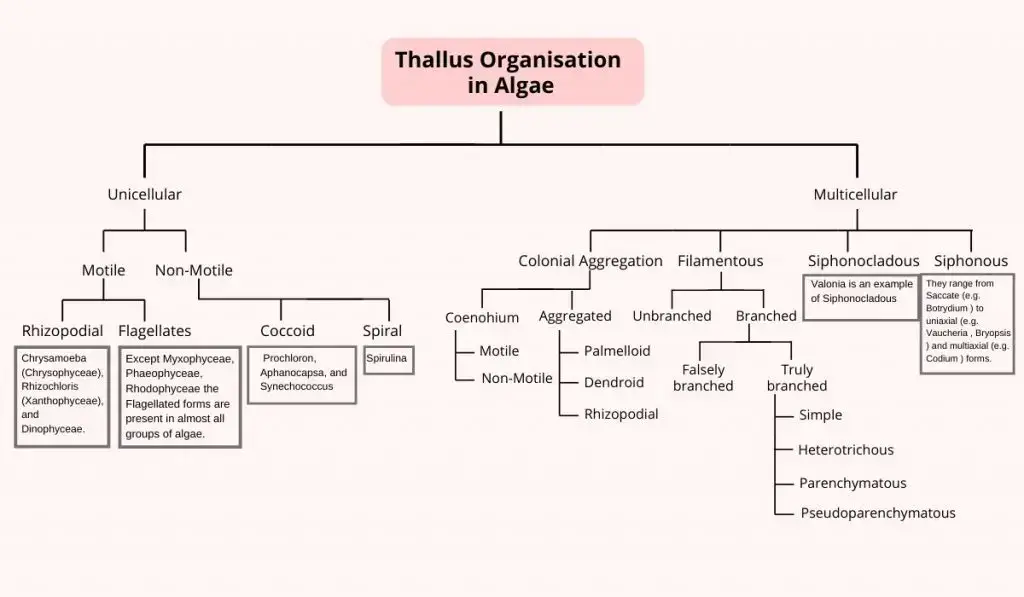
The algal thallus organization can be classified in these following groups such as;
1. Unicellular Forms
Unicellular algae consist of a single cell and can exhibit a variety of shapes, including rounded, pear-shaped, oblong, or spherical. These simple organisms can be categorized into two main types based on their motility:
- Unicellular Motile Algae
- Rhizopodial Type: These algae move using pseudopodia, which are temporary projections of the cell membrane. This type of movement is akin to amoeboid motion and allows the organism to navigate through its environment.
- Flagellated Type: These algae possess one or more flagella, which are whip-like structures that propel the cell through its aquatic habitat. Flagella enable motility and can vary in number and arrangement.
- Unicellular Non-Motile Algae
- Coccoid Type: Non-motile unicellular algae of this type are generally spherical or oval. They remain stationary and often form colonies or aggregates.
- Spiral Type: These algae are characterized by their spiral arrangement of cells, which can aid in buoyancy and nutrient acquisition in their aquatic environments.
a. Motile form of Unicellular Algae
Unicellular algae exhibit motility through two primary mechanisms: rhizopodial movement and flagellar movement. These forms allow algae to navigate their aquatic environments and fulfill various ecological roles.
- Rhizopodial Motile Forms
- Cell Structure: Rhizopodial algae are characterized by a naked protoplast, meaning they lack a rigid cell wall. This structural adaptation allows them to change shape and size extensively.
- Locomotion: These algae utilize cytoplasmic projections known as pseudopodia or rhizopodia for movement. This type of movement, termed ameboid movement, involves extending and retracting these projections to facilitate locomotion.
- Examples: Notable examples include Rhizochloris from the Xanthophyceae and Chrysamoeba from the Chrysophyceae. These organisms demonstrate the rhizopodial mode of motility, where pseudopodia are used to navigate their environment.
- Flagellated Motile Forms
- Cell Structure: Flagellated algae possess one or more flagella, which are whip-like appendages that drive the cell through the water. These algae can be spherical, elongate, ovoid, or round in cross-section.
- Locomotion: The movement is powered by the flagella, which can be of various types:
- Equal or Unequal Flagella: Flagella can be of equal length or differ in length, depending on the species.
- Tinsel or Whiplash Flagella: Flagella may be tinsel-like, with lateral projections, or whiplash-like, with a smooth surface.
- Examples: Flagellated unicellular algae are found across many groups except for Phaeophyceae, Rhodophyceae, Bacillariophyceae, and Myxophyceae. Common examples include Chlamydomonas, which typically has two flagella, and Euglena, which is known for its prominent flagellar movement. Other examples include Cryptomonas, Heterochloris, and Chlorogonium.
b. Non Motile form of Unicellular Algae
Non-motile unicellular algae lack the ability to move independently and are categorized into two primary types: coccoid and spiral forms. These forms differ in their structural features and ecological roles.
- Coccoid Form
- Cell Structure: Coccoid algae are characterized by their rigid cell walls and absence of flagella. This rigidity impedes their movement, making them inherently non-motile. However, during reproductive stages, some coccoid forms may exhibit temporary motility.
- Shape and Arrangement: Typically, coccoid algae are small and spherical. They may exist as solitary cells or in groups embedded within a gelatinous matrix. Some forms display slight elongation and can be distinguished by their base and apex.
- Examples: Common examples include Prochloron, Aphanocapsa, and Synechococcus. These organisms are predominantly found in the class Xanthophyceae, which comprises a significant portion (about 70%) of coccoid algae.
- Spiral Form
- Cell Structure: Spiral forms are unique in their filamentous structure, featuring a spiral arrangement of cells. This spiral configuration is a distinctive trait of these non-motile algae.
- Examples: Spirulina is a well-known example of spiral unicellular algae. These organisms exhibit a filamentous structure that spirals around an axis, contributing to their identification.
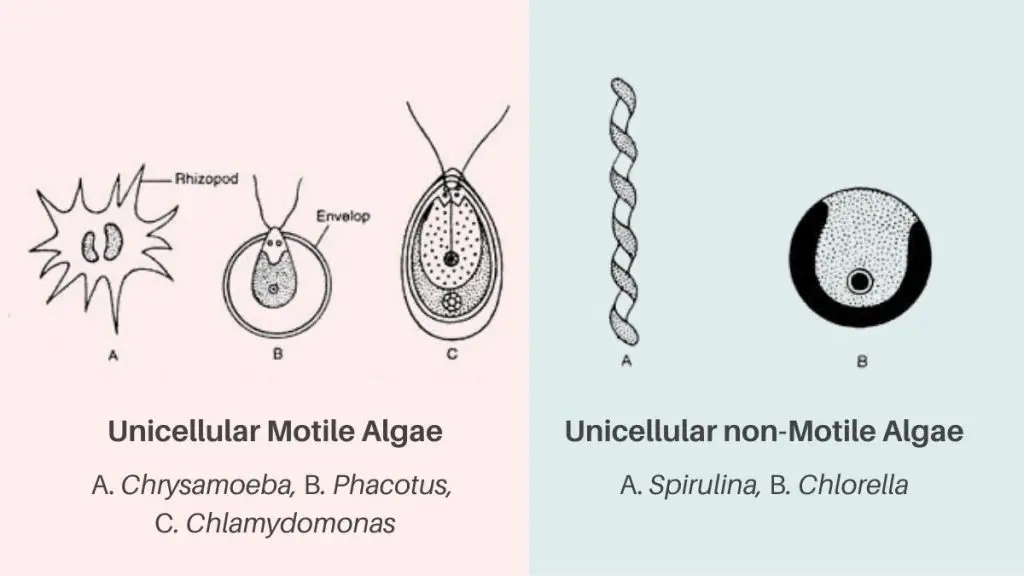
2. Multicellular Forms
Colonial aggregation in algae refers to a mode of organization where unicellular algae cluster together within a common mucilaginous matrix. This arrangement allows the cells to remain connected through cytoplasmic threads, forming a cohesive structure.
Types of Colonial Aggregation
- Coenobium
- Description: Coenobium represents a specific type of colonial aggregation where the cells are organized into a fixed number and arrangement. This arrangement is categorized into two distinct groups based on motility:
- Motile Coenobium:
- Characteristics: The cells are flagellated, meaning they possess flagella that enable movement through coordinated beating. These colonies can actively swim and maneuver.
- Examples:
- Volvox: A well-known example that forms spherical colonies with flagella protruding outward.
- Pandorina and Eudorina: These genera also exhibit motility through flagella.
- Non-Motile Coenobium:
- Characteristics: These colonies lack flagella, rendering them non-motile. The cells remain stationary within a gelatinous matrix but still exhibit a structured arrangement.
- Examples:
- Scenedesmus: Exhibits a characteristic arrangement in which cells align in a single plane.
- Hydrodictyon: Forms a distinctive net-like structure composed of interconnected cells.
- Motile Coenobium:
- Description: Coenobium represents a specific type of colonial aggregation where the cells are organized into a fixed number and arrangement. This arrangement is categorized into two distinct groups based on motility:
- Aggregated Forms
- Description: Aggregated forms are characterized by irregular clustering of cells, resulting in colonies with varied sizes and shapes. These forms are categorized into three types:
- Palmelloid:
- Characteristics: In this form, cells are embedded within an amorphous, gelatinous matrix. Each cell functions independently within the colony.
- Examples:
- Tetraspora and Palmodictyon (Chlorophyceae)
- Gloeochloris and Chlorosaccus (Xanthophyceae)
- Phaeocystis (Chrysophyceae) and Microcystis (Cyanophyceae)
- Dendroid:
- Characteristics: These colonies resemble microscopic trees due to their branching structure. The cells exhibit variable shapes and sizes, with mucilaginous threads at their bases contributing to their tree-like appearance.
- Examples:
- Prasinocladus, Ecballocystis, and Chrysodendron
- Rhizopodial:
- Characteristics: Cells are connected by rhizopodia, which are specialized cytoplasmic projections.
- Examples:
- Chrysidiastum
- Palmelloid:
- Description: Aggregated forms are characterized by irregular clustering of cells, resulting in colonies with varied sizes and shapes. These forms are categorized into three types:
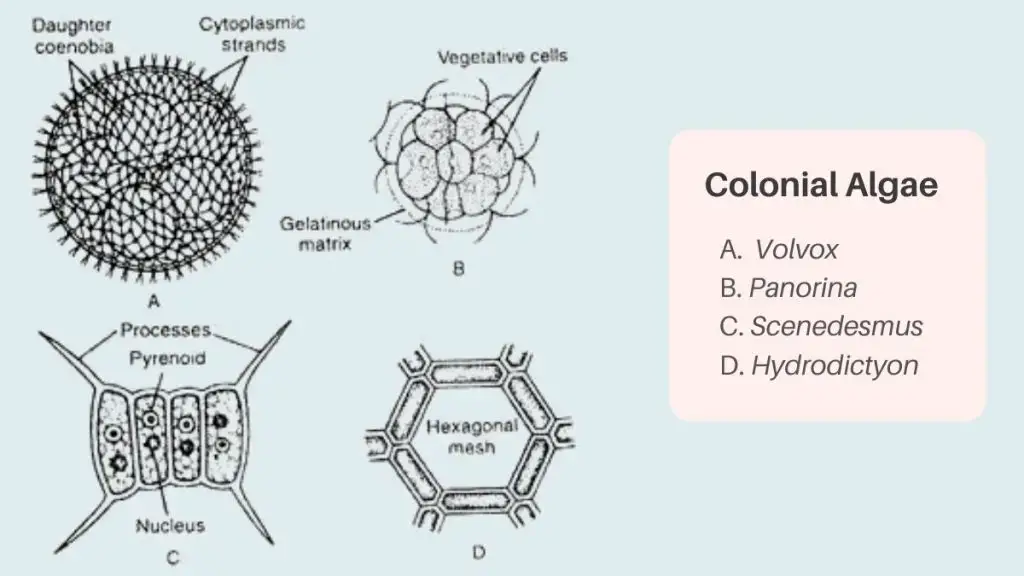
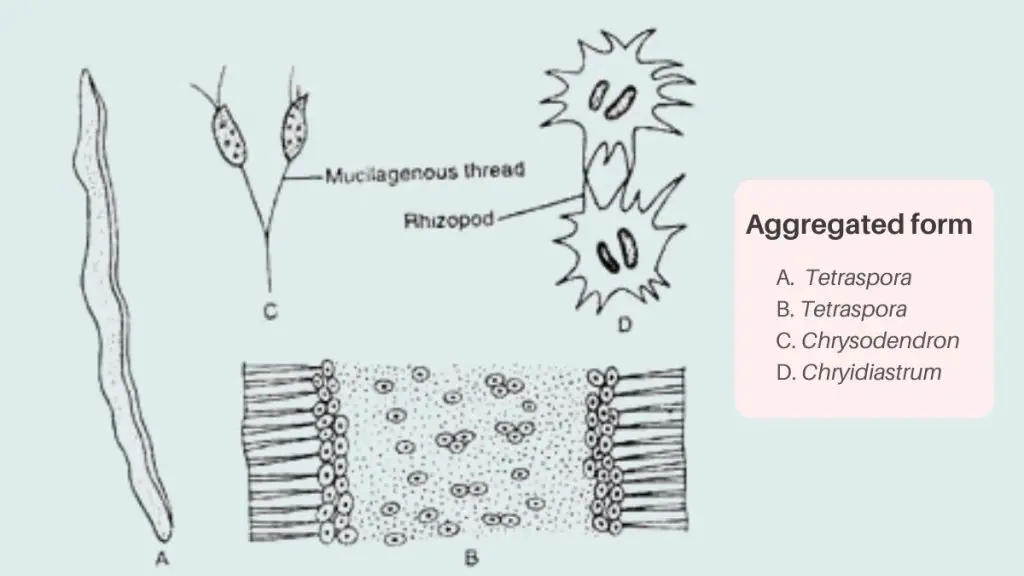
B. Filamentous Forms
Filamentous forms of algae are characterized by cells that divide repeatedly in a single plane and direction, resulting in a thread-like or chain-like structure. These structures are crucial for understanding the growth and organization of various algal species.
Types of Filamentous Forms
- Unbranched Filament
- Description: Unbranched filaments consist of cells that are arranged end-to-end without lateral branching. These can be either free-floating or attached to a substrate.
- Free-Floating:
- Characteristics: These filaments do not exhibit differentiation into basal or apical ends. These filaments are not differentiated into basal and apical ends and float freely in the water.
- Example: Spirogyra—a common example known for its helical chloroplast arrangement.
- Attached to Substratum:
- Characteristics: These filaments are attached to a substrate and exhibit differentiation into basal (base) and apical (tip) regions. These filaments attach to a substrate and exhibit differentiation into a base (attachment point) and an apex (free end).
- Examples:
- Ulothrix: An algae species that adheres to surfaces while maintaining a simple unbranched structure.
- Oedogonium: Characterized by its unbranched structure and attachment to substrates.
- Colonial Unbranched:
- Characteristics: In these forms, the filaments aggregate to form a colony while remaining unbranched.
- Example: Nostoc represents a colonial unbranched filamentous form.
- Free-Floating:
- Description: Unbranched filaments consist of cells that are arranged end-to-end without lateral branching. These can be either free-floating or attached to a substrate.
- Branched Filament
- Description: Branched filaments arise when cells divide in more than one plane, resulting in a branched structure. These are further classified into two types:
- Falsely Branched:
- Characteristics: This type of branching is not true branching but appears due to the fragmentation of the trichome. This fragmentation often occurs due to the degeneration of an intercalary cell or the formation of biconcave separation discs, leading to growth from the ends of the fragments.
- Example: Scytonema—a filamentous algae showing a false branching pattern due to degeneration.
- Truly Branched:
- Characteristics: True branching occurs when lateral outgrowths form through repeated transverse divisions. This type of branching is more complex and can be categorized into four forms:
- Simple Filament:
- Characteristics: The filamentous algae are attached to the substratum by a basal cell, with branches emerging from other cells along the filament.
- Example: Cladophora—a common example that exhibits simple filamentous branching.
- Heterotrichous Habit:
- Characteristics: The algae exhibit a two-part system with a prostrate (horizontal) and erect (vertical) growth form.
- Examples:
- Fritschiella
- Ectocarpus
- Draparnaldiopsis
- Stigoclonium
- Parenchymatous Forms:
- Characteristics: In these forms, the primary filament cells divide in all directions, leading to a loss of the filamentous structure and forming a more complex parenchymatous structure.
- Examples:
- Porphyra
- Ulva
- Enteromorpha
- Pseudoparenchymatous Habit:
- Characteristics: These forms develop when central or axial filaments fuse to form a structure resembling parenchyma, often resulting from the interweaving of filaments.
- Examples:
- Batrachospermum
- Polysiphonia
- Types:
- Uniaxial Type:
- Characteristics: The thallus features a single main axis with additional branching.
- Examples: Batrachospermum, Spermatochnus (Phaeophyceae), and Polysiphonia (Rhodophyceae).
- Multiaxial Type:
- Characteristics: Multiple axes form a compact structure with central and lateral branches.
- Examples: Chondrus and Scinaia represent multiaxial pseudoparenchymatous forms.
- Uniaxial Type:
- Simple Filament:
- Characteristics: True branching occurs when lateral outgrowths form through repeated transverse divisions. This type of branching is more complex and can be categorized into four forms:
- Falsely Branched:
- Description: Branched filaments arise when cells divide in more than one plane, resulting in a branched structure. These are further classified into two types:
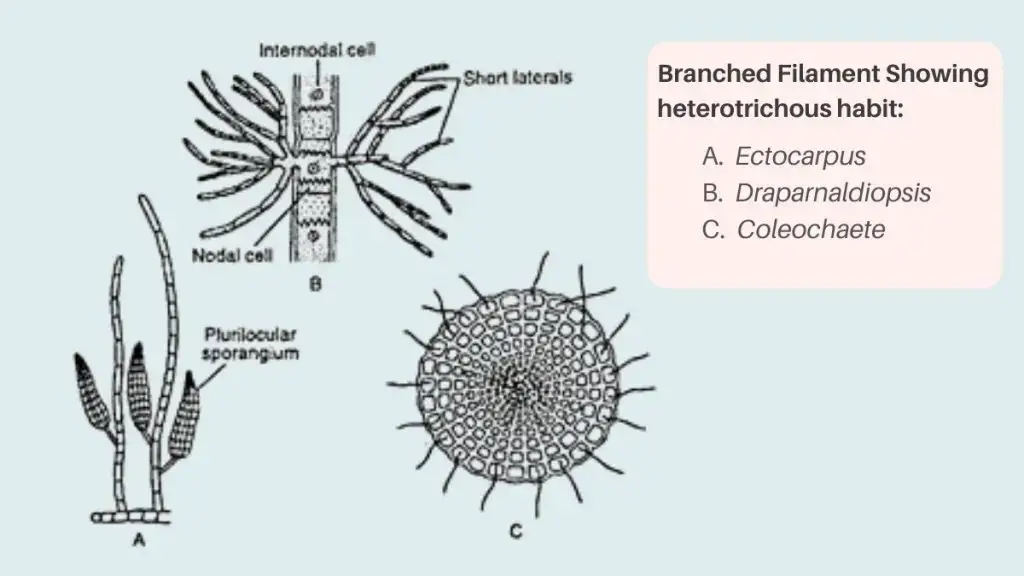
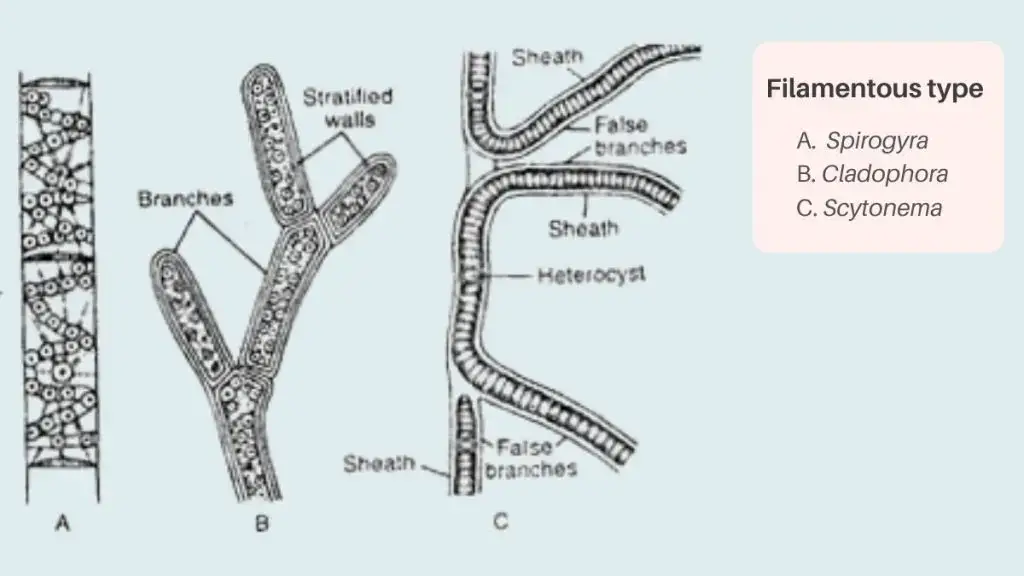
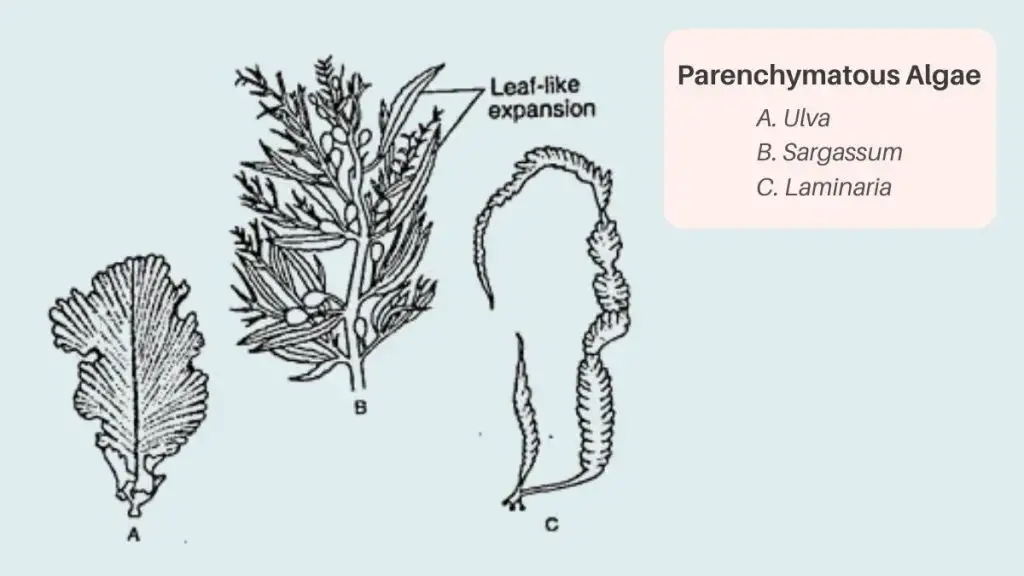
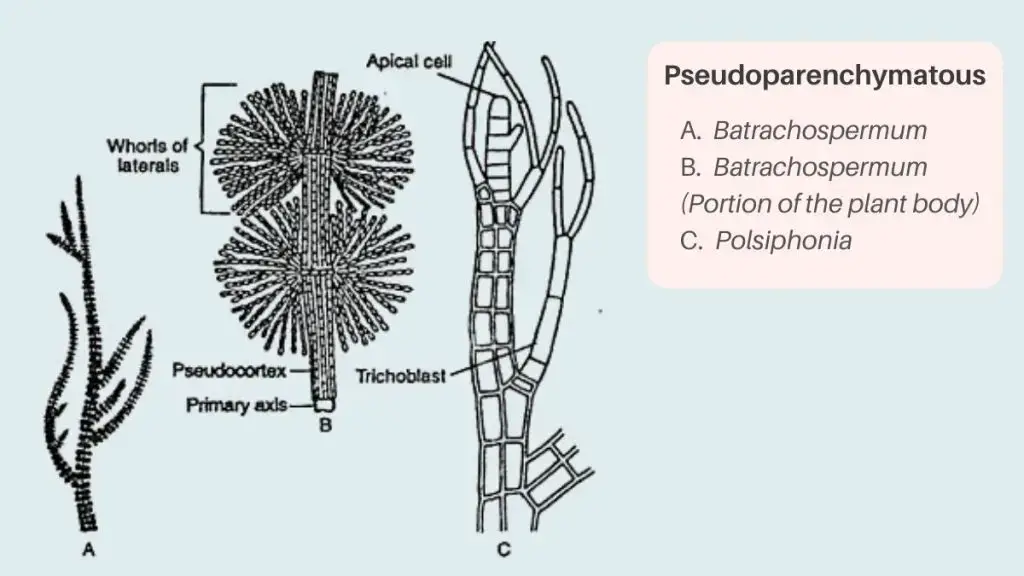
C. Siphonocladous Organization
Siphonocladous organization is a structural feature found exclusively in certain members of the class Chlorophyceae. This type of organization is characterized by specific arrangements and properties of filaments and cells, which distinguish it from other algal structures. Here is a detailed explanation of siphonocladous organization:
- Definition and General Characteristics
- Siphonocladous Organization involves filaments that can be either unbranched or branched.
- These filaments are composed of multinucleate or semi-coenocytic cells, meaning that they contain multiple nuclei within a shared cytoplasmic space without distinct cell walls separating each nucleus.
- This organization is primarily observed in green algae and is a notable characteristic of certain Chlorophyceae members.
- Types of Filaments
- Unbranched Filaments: Examples include Urospora and Chaetomorpha. These filaments grow in a linear, unbranched manner and maintain their multinucleate structure throughout.
- Branched Filaments: Examples include Acrosiphonia and Cladophora. These filaments exhibit branching patterns while still retaining a multinucleate cell organization.
- Distinctive Examples
- Valonia: This is a notable example of siphonocladous organization. Valonia is distinguished by its spherical vesicles, which can reach up to 10 cm in diameter, making it one of the largest plant cells. It exemplifies the siphonocladous structure due to its large size and multinucleate nature.
- Functional Implications
- Nutrient Transport: The multinucleate structure facilitates efficient nutrient and resource distribution throughout the filament. Since the cells are not separated by walls, nutrients can diffuse more readily across the entire filament.
- Structural Support: The semi-coenocytic nature provides structural support, allowing the filaments to withstand various environmental stresses.
- Significance
- The siphonocladous organization represents an adaptation that enhances the efficiency of nutrient transport and cellular function in green algae.
- It provides insight into the diversity of algal structures and their evolutionary adaptations.
D. Siphonous Organization
Siphonous organization is a specialized structural form found in certain marine green algae (Chlorophyceae) and some yellow-green algae (Xanthophyceae). This organization is characterized by the presence of coenocytic thalli, which exhibit a multinucleate structure without typical cross-wall formation. The following points detail the features and types of siphonous organization:
- Definition and General Characteristics
- Siphonous Organization involves the development of a coenocytic thallus, which is a large, multinucleate cell with a continuous cytoplasmic network and no internal septa.
- The thallus grows as a hollow, tube-like structure called a coenocyte, which is not divided by internal cross-walls. Instead, it maintains a single, continuous cytoplasm with multiple nuclei dispersed throughout.
- Growth and Structure
- Coenocytic Thallus: The plant body consists of a long, multinucleate tube that can range from simple to complex forms. The thallus lacks internal septa, allowing for uninterrupted growth and a large, central vacuole surrounded by chloroplasts and nuclei within the peripheral cytoplasm.
- Free Nuclear Division: Nuclear divisions occur without cytokinesis, leading to the formation of a multinucleate structure. This free nuclear division results in a coenocytic arrangement, which is a defining feature of siphonous organization.
- Types of Siphonous Forms
- Saccate Forms: These are characterized by sac-like or bag-like structures. An example is Botrydium, which exhibits a saccate thallus.
- Uniaxial Forms: These forms have a single central axis with no branching. An example is Vaucheria, which demonstrates a uniaxial siphonous structure.
- Multiaxial Forms: These have multiple axes or branching structures. An example is Codium, which displays a complex, multiaxial thallus.
- Functional Implications
- Nutrient Transport: The coenocytic nature allows for efficient nutrient distribution throughout the large, continuous cytoplasmic space.
- Structural Adaptation: The absence of cross-walls and the presence of a central vacuole provide structural flexibility and resilience to environmental stresses.
- Significance
- Siphonous organization represents an adaptation to specific ecological niches, particularly in marine environments where large, multinucleate structures can efficiently capture and utilize resources.
- This type of organization offers insights into the diversity of algal structures and their evolutionary adaptations.
E. Parenchymatous Forms
Parenchymatous forms represent a significant modification of the filamentous structure observed in certain algae. This organizational type arises from the division of cells in multiple planes, leading to the formation of a more complex thallus. The following points outline the key features and variations of parenchymatous forms:
- Definition and Formation
- Parenchymatous Organization occurs when cells within a filamentous thallus divide not only along the length but also in multiple planes. This process results in the development of a more complex, three-dimensional structure.
- Primary Division: Initially, the thallus starts as a simple filament, but as cells divide in several directions, they form a parenchymatous structure. This results in a tissue organization where cells are arranged in a compact and often irregular manner.
- Types of Parenchymatous Forms
- Foliose Forms: These are characterized by leaf-like, flat structures. An example is Ulva, commonly known as sea lettuce. In foliose forms, the thallus is broad and flat, resembling leaves or blades, which enhances surface area for photosynthesis.
- Tubular Forms: This type features cylindrical or tubular structures. Enteromorpha, for instance, exhibits a tubular thallus that is often found in aquatic environments. The tubular shape aids in maintaining buoyancy and efficient nutrient absorption.
- Highly Developed Structures: Some parenchymatous forms exhibit complex structures with highly specialized tissues. Examples include:
- Chara: This genus displays a complex structure with a well-defined axis and branched filaments, resembling a higher level of organization among green algae.
- Fucus and Laminaria: These brown algae present large, differentiated thalli with specialized tissues adapted to various marine environments.
- Functional Implications
- Enhanced Functionality: The parenchymatous organization allows for increased surface area and complex internal structure, which can improve nutrient uptake, gas exchange, and overall metabolic efficiency.
- Structural Adaptation: The diversity in structure, from foliose to tubular to highly developed forms, reflects adaptations to different environmental conditions and ecological niches.
- Significance
- Evolutionary Adaptation: The development of parenchymatous forms represents an evolutionary adaptation that allows algae to exploit a variety of ecological roles and environments.
- Ecological Impact: These forms play crucial roles in their habitats, from providing food and habitat for marine organisms to contributing to the primary productivity of aquatic ecosystems.
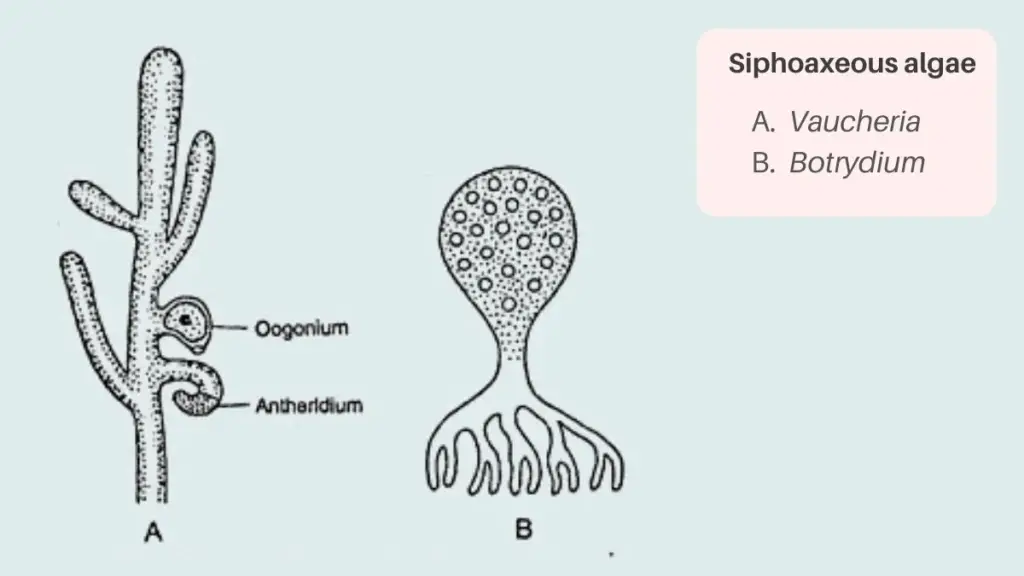
Cheatsheet on Thallus Organisation in Algae
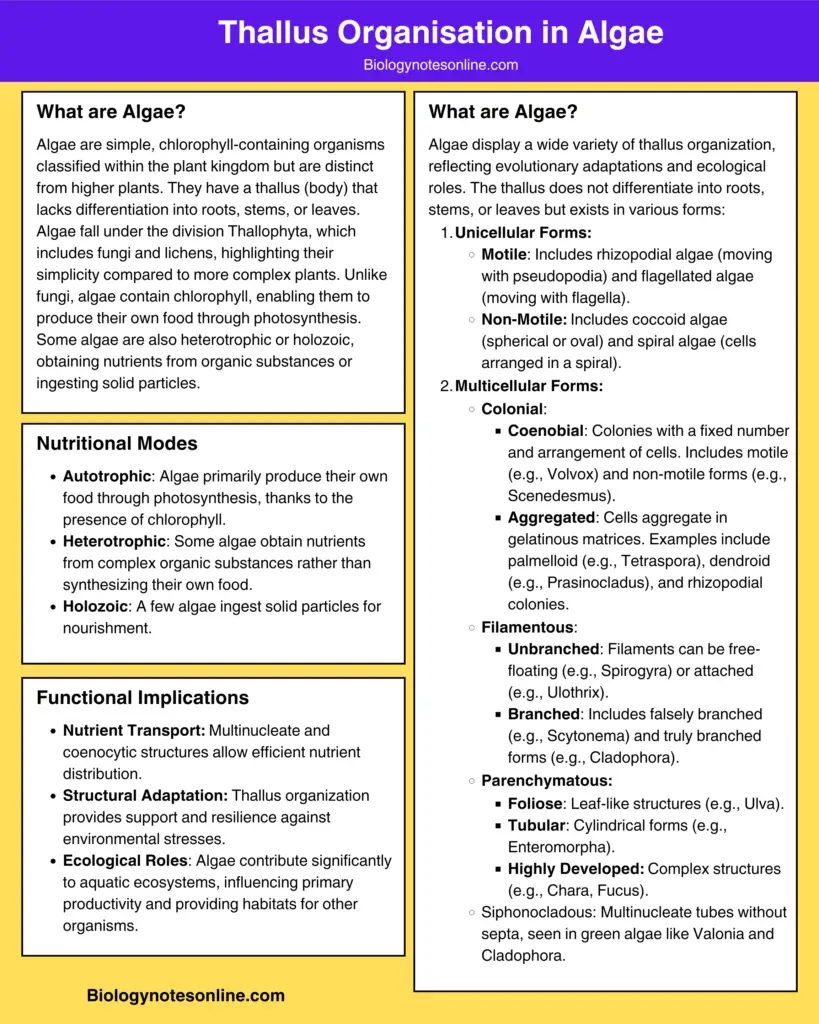
References
- https://www.lndcollege.co.in/syllabus/co_po/Range%20of%20Thallus%20Structure%20in%20Algae.pdf
- https://www.vicas.org/NAAC/SSR/CIV/4.3.4/bot/bot33.pdf
- https://www.goalparacollege.ac.in/online/attendence/classnotes/files/1686289684.pdf
- https://gyansanchay.csjmu.ac.in/wp-content/uploads/2021/12/1.-Range-of-thallus-structure-in-Algae-3.pdf
- https://www.biologydiscussion.com/algae/thallus-organisation-in-algae-botany/53555
- https://patnawomenscollege.in/upload/e-content/Thallus-organization-in-algae.pdf